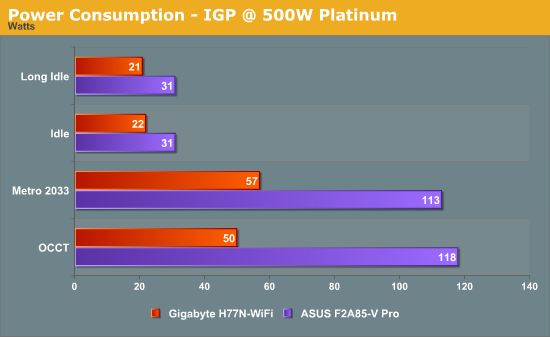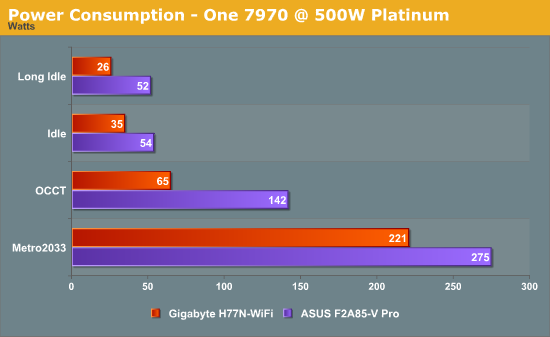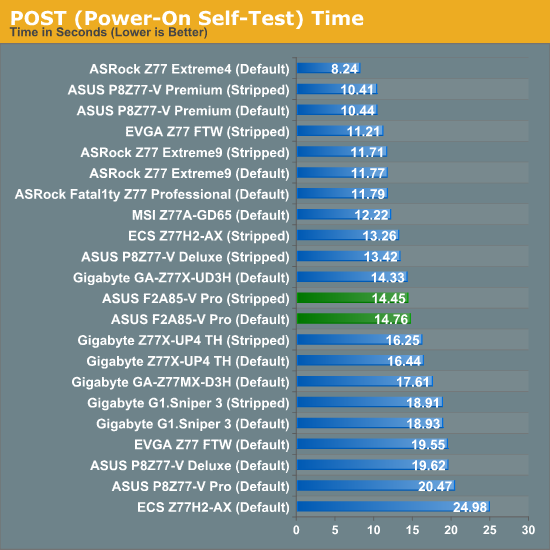ASUS F2A85-V Pro Review: A Look at FM2 with A85X
by Ian Cutress on October 10, 2012 11:20 AM EST- Posted in
- Motherboards
- Asus
- Trinity
- FM2
- A85X
Many thanks to...
We must thank the following companies for kindly donating hardware for our test bed:
OCZ for donating the Power Supply and USB testing SSD
Micron for donating our SATA testing SSD
G.Skill for donating our memory kits
ASUS for donating AMD GPUs and some IO testing kit
ECS for donating NVIDIA GPUs
Gigabyte for donating the i3-3225 used for comparison
Comparison of AMD Processors
On the following benchmarks, we will use results from comparible tests with previous processor families over the past 18 months. For AMD, this means we can compare the new Piledriver modules to Llano with its Stars cores, Phenom II and Thuban, and Zambezi with Bulldozer. The following processors are ones we have a variety of results for:
A6-3650 (32nm, 2.6 GHz) – Llano, 4 Stars cores
A8-3850 (32nm, 2.9 GHz) – Llano, 4 Stars cores
X6 1100T (45nm, 3.7 GHz Turbo) – Phenom II, 6 Thuban cores
FX-8150 (32nm, 4.2 GHz Turbo) – Zambezi, 4 Bulldozer modules
A10-5800K (32nm, 4.2GHz) – Trinity, 2 Piledriver modules
On the Intel side, we have the following:
Core i7-3960X (32nm, 3.9 GHz Turbo) – Sandy Bridge-E, 6 cores / 12 threads
Core i7-3770K (22nm, 3.9 GHz Turbo) – Ivy Bridge, 4 cores / 8 threads
Core i5-2500K (32nm, 3.7 GHz Turbo) – Sandy bridge, 4 cores / 4 threads
Core i3-3225 (22nm, 3.3 GHz) – Ivy Bridge, 2 cores / 4 threads
The aim of AMD is to put the A10 square on the bow of the Core i3-3225. For comparison, the A10-5800K release price is $122, whereas the boxed version of the i3-3225 should be ~$144.
Test Setup
| Processor |
AMD Trinity A10-4800K APU 2 Modules, 4 Threads, 3.8 GHz (4.2 GHz Turbo) |
| Motherboards | ASUS F2A85-V Pro |
| Cooling | beQuiet DarkPro CPU Cooler |
| Power Supply |
OCZ 1250W Gold ZX Series Rosewill SilentNight 500W Platinum PSU |
| Memory | G.Skill TridentX 4x4 GB DDR3-2400 10-12-12 Kit |
| Memory Settings | XMP |
| Video Cards |
ASUS HD7970 3GB ECS GTX 580 1536MB |
| Video Drivers |
Catalyst 12.3 NVIDIA Drivers 296.10 WHQL |
| Hard Drive | Corsair Force GT 60 GB (CSSD-F60GBGT-BK) |
| Optical Drive | LG GH22NS50 |
| Case | Open Test Bed - DimasTech V2.5 Easy |
| Operating System | Windows 7 64-bit |
| SATA Testing | Micron RealSSD C300 256GB |
| USB 2/3 Testing | OCZ Vertex 3 240GB with SATA->USB Adaptor |
Our main Intel comparison system is a to-be-reviewed Gigabyte H77N-WiFi with a 65W dual core i3-3225 processor against the 100W A10-5800K.
Power Consumption
Power consumption was tested on the system as a whole with a wall meter connected to a Rosewill 500W 80PLUS Platinum SilentNight power supply. As I am in the UK on a 230-240 V supply this leads to ~75% efficiency at low loads, and 90%+ efficiency between 20% and 100% loading. This method of power reading allows us to compare the power management of the UEFI and the board to supply components with power under load, and includes typical PSU losses due to efficiency. These are the real world values that consumers may expect from a typical system (minus the monitor) using this motherboard.


From our internal results, testing with 1 GPU on the 500W Platinum and 1250W Gold gave similar power readouts (Idle/OCCT/Metro on 500W gave 54/142/275, on 1250W gave 59/148/280), which means the 1250W is still good for comparison on the system. However for IGP testing, it was important to use the 500W. Our main comparison is the i3-3225 dual core Intel system on the to-be-reviewed Gigabyte H77N-WiFi, though the wattage between the processors accounts for large differences under load. At idle the larger ATX F2A85-V Pro does consume more power – if we get an ITX FM2 system, this will be a better comparison to test.
POST Time
Different motherboards have different POST sequences before an operating system is initialized. A lot of this is dependent on the board itself, and POST boot time is determined by the controllers on board (and the sequence of how those extras are organized). As part of our testing, we are now going to look at the POST Boot Time - this is the time from pressing the ON button on the computer to when Windows starts loading. (We discount Windows loading as it is highly variable given Windows specific features.) These results are subject to human error, so please allow +/- 1 second in these results.

The F2A85-V Pro uses ASUS’ new CAP BIOS system, designed to aid in POST times across their motherboard range. It helps a little here, as normally for ATX boards POST times are in the 16+ second region – the CAP BIOS reduces this to just under 15 seconds.










66 Comments
View All Comments
just4U - Wednesday, October 10, 2012 - link
Have you used ivy bridge or even set up any? Those puppies get quite warm and temperatures are all over the place. Hell I opted for a 2700K just because of that and prices were comparable. Using the 5800 (been working with it a few days now) it runs cool rarely going over 35C and usually staying in the low 20s in my 10 year old lian-li case (/w 3 80mm fans.. doesn't support bigger ones)CeriseCogburn - Saturday, October 13, 2012 - link
amd fanboy fails again. It's getting irritating with your idiocy and lies and pretense as if you know something. You know exactly nothing." In case of single-threaded load processors with different microarchitectures demonstrate dramatically different levels of power consumption. And here we have every right to state that Ivy Bridge microarchitecture is the most energy-efficient among all testing participants. Core i3 manufactured with 22 nm process do win the promised 8-10 W of power from their predecessors and demonstrate overwhelming advantage over the competitor’s offerings. "
No doubt that Core i3 processors from the new 3000 series will make the most energy-efficient systems. Their power consumption and therefore heat dissipation are significantly lower than by all other platforms, and their advantages over the systems with dual-core Sandy Bridge processors is between 10 and 20 W. This makes Core i3 with Ivy Bridge microarchitecture a perfect choice for compact and energy-efficient systems. And, by the way, for these particular systems Intel has special energy-efficient Core i3 CPU modifications with 35 W TDP instead of 55 W.
LOL - the amd fanboy spews his lies, and gets owned, again, after insulting the poster WHO IS CORRECT.
http://www.xbitlabs.com/articles/cpu/display/core-...
aryonoco - Wednesday, October 10, 2012 - link
At a few points in the article, Ian mentions that the chipset supports RAID5 and might therefore be a good candidate for a SOHO NAS system. My question is, does anyone who builds a SOHO NAS system actually use these integrated hardware RAIDs?Sure, nothing beats a good and proper RAID controller, but those cost upward of $300 and from experience, these integrated RAID controllers barely perform well. They are generally much slower than software RAID, and tougher to recover from failures. Nearly everyone I know who has built their own NAS goes for software RAID, and any modern OS has better software RAID than these chipsets generally provide.
The other reason not to consider Trinity for a NAS build is that power consumption is generally a major factor in a device that's 24/7 on, and Ivy Bridge beats Trinity in that regards hands down. Also, Trinity's main advantage over Ivi Bridge, that of a better GPU, is of no use in a NAS.
So, I ask again, is Trinity actually such a good choice for a NAS build? I see a place for it in a HTPC build, but pretty much in nothing else.
zappb - Wednesday, October 10, 2012 - link
Trinity has a lower idle power consumption - depending on the usage scenario, it should be cheaper to run than the ivy bridge in a NASsolarisking - Wednesday, October 10, 2012 - link
Are you guys still working on an iPhone 5 review? It's been weeks!!!Zink - Wednesday, October 10, 2012 - link
If they still don't have that done, how are they going to keep up with all of the Windows releases set to hit in 2 weeks? Flagship Windows phones and tablets probably deserve just as much attention as the iPhone and there are releases covering the whole value spectrum. I hope the iPad Mini doesn't get some 20 page review while windows tablets get the standard windows laptop type review.Snotling - Thursday, October 11, 2012 - link
There won't be an iPad mini... Unless Apple has lost its sense of direction. (which all things considered might be the case)Phiro69 - Wednesday, October 10, 2012 - link
Ian mentions a few times the motherboard - at $140 - appears overpriced for the performance & such. And yes, this Trinity sku is only somewhat comparable to an i3. But isn't the point of Trinity + FM2 to be somewhat future-insulated? As in, drop in another FM2 sku 6-12 months from now and watch your CPU & GPU performance skyrocket? Didn't AMD say FM2 is going to be around for the this gen and the next gen of processors?You might still have to be abit of an AMD fan boy to buy this combo now, but it would make a solid work PC and/or light gaming PC and a year from now, I bet $125 would drop in a huge boost in performance, without having to replace the rest of your system.
Urizane - Monday, October 15, 2012 - link
"But isn't the point of Trinity + FM2 to be somewhat future-insulated?"This depends on whether FM2 fades as quickly as FM1 and the length of time implied by 'somewhat'. Perhaps FM1 was around for 'somewhat' of a long time...maybe.
Mugur - Thursday, October 11, 2012 - link
HTPC - checked.Cheap file-server (8 x SATA 3 ports is great - I wonder whether mATX boards will have all 8) - checked.
Home Office / light gaming - checked.